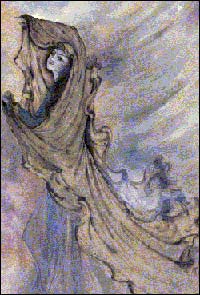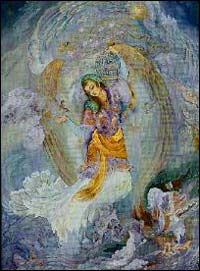| |
 The
seeds of modern Persian classical dance were sown during the
Qajar dynasty (1780-1906). Fath 'Ali Shah (1798-1834) in particular
devoted a great deal of the royal treasury to all forms of art,
including dance. He was said to have "maintained a stately
court and a large harem or anderun full of ladies groomed to
the perfection of Persian taste for the amusement and pleasure
of the Shah" . His successor, his grandson Muhammad Shah,
furthered the support of dance, and "the dancing girls,
those lavishly decorated women who typified the luxurious living
of the monarchy" . The
seeds of modern Persian classical dance were sown during the
Qajar dynasty (1780-1906). Fath 'Ali Shah (1798-1834) in particular
devoted a great deal of the royal treasury to all forms of art,
including dance. He was said to have "maintained a stately
court and a large harem or anderun full of ladies groomed to
the perfection of Persian taste for the amusement and pleasure
of the Shah" . His successor, his grandson Muhammad Shah,
furthered the support of dance, and "the dancing girls,
those lavishly decorated women who typified the luxurious living
of the monarchy" .
"The most beautiful women in Persia
are devoted to the profession of dancing; the transparency of
their shift, which is the only covering they use to conceal
their persons, the exquisite symmetry of their forms, their
apparent agitation, and the licentiousness of their verses,
are so many incentives to a passion which requires more philosophy
than the Persians possess to restrain."
After the Constitutional Revolution of 1906, Persia became increasingly
influenced by the West, largely as a result of political intrigues
with Russia, England, and Germany. The decline in the monarchy
was paralleled by a decline in the support and status of dancers.
Thus the Persian professional classical dance tradition was
maintained by prostitutes and courtesans; these women, and also
dancing boys, were the only public performers. Particularly
in urban areas professional dancers traditionally performed
with troops of musicians, singers, comedians, actors, and other
entertainers, These itinerant groups performed on the street
and could be hired for weddings and other festivities. Their
performances could be vulgar, involving suggestive lyrics and
movements.
In a visit to a house of ill-repute, a Swedish journalist writes
of a dance performance she witnessed, performed by girls of
the house, with musical accompaniment provided by the cooks:
 "Two
lovely girls prepared for the dance.....went to change and came
out again in wide green trousers, embroidered white bodices,
which did not cover more than their breasts; and with castanets
of silver blended metal on their fingers. "Two
lovely girls prepared for the dance.....went to change and came
out again in wide green trousers, embroidered white bodices,
which did not cover more than their breasts; and with castanets
of silver blended metal on their fingers.
The musicians tuned up and the two girls began.
Their foot movements were controlled and unimportant. It was
the upper part of their bodies which moved. Sinuous and supple,
they waved their arms gracefully backwards and forwards above
their heads, while their fingers played with the castanets so
that they sometimes clapped like Spanish castanets and sometimes
rang like a chime of bells.......The tempo of the dance increased
until the dancers' feet flew over the mat so lightly that the
soft thudding of their feet was scarcely even heard.
Urged on by the dance and the music, the audience began to shout
to the girls, who suddenly stood on their heads, turned somersaults,
and made snake-like movements. The audience was delighted."
For non-professionals, the Persian classical dance tradition
has largely been maintained in private homes. Persian women
begin to learn to dance when they are small girls. They are
taught by family members, or learn to imitate their elders,
to provide entertainment for the family. There were also, prior
to the 1979 revolution, classes taught by non-Muslim women,
Jews and Armenian Christians, attended by proper Iranian ladies
in great secrecy . Girls learn the Iranian cultural bias against
females dancing in front of anyone other than the family; so
they like to dance, but learn not to dance in public, and express
reserve when asked to dance even at private parties outside
the family.
In the 1950's and 60's, Persian classical dance began a revival,
which removed it from a context of prostitution and low-class
nightclubs. Dancers began to appear on television and the government
began to sponsor dance companies that performed classical and
folk dance (recreational dance of the villages and tribes).
|